Nican Mopohua
Nican Mopohua
The summary of the text from this book was made by Father Johann Roten, S.M. with the permission of the publisher and author. Stream of Light, queen of Tepeyacac. Translated from the Spanish text of Elise Dac, with illustrations by Fernando Leal. Mexico, c1952.
The story of Our Lady of Guadalupe in Nahuatl
Don Antonio Valeriano
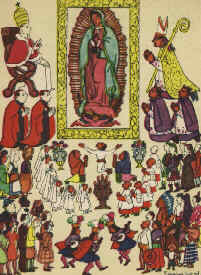
Our Lady of Guadalupe is very popular. Studies, devotional literature, pictures and even web sites abound. However, there is a document about Guadalupe which is not often mentioned. It was written in 1545, fourteen years after the Guadalupe event of December 9 to 12, 1531. Called Nican Mopohua because of the exact chronological order in which it relates the various phases of the apparitions, this account is also the first and oldest written source on Guadalupe. It is considered a masterpiece of Nahuatl literature and was written by Don Antonio Valeriano (see: Nican Mopohua). The following text is a condensed version of the translation made by Primo Feliciano Velazquez from the original in Nahuatl. Elise Dac translated the Spanish text into English. The story was published 1951 by Publisher Dac, Mexico/Paris, under the title Stream of Light, Queen of Tepeyac. Fernando Leal made the illustrations inspired by native Indian codices. In the Nahuatl language of symbols birds, as well as winged angels, are expressions of divine mediation and flowers point to the truth of things. Because hill of Tepeyac where Juan Diego first met Our Lady has the shape of a face, it is known as the "Hill of the Nose."
Guadalupe is more than a shrine. It is a national monument. Its message has been imprinted on the soul of the Mexican people. Pope Leo XIII expressed this in 1895 when he wrote, "The Mexican people rejoice before your wonderful image ... may it preserve its faith, strong and immovable."
Nican Mopohuyua
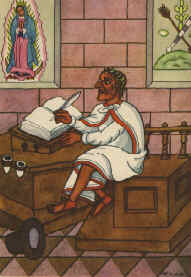
Don Antonio Valeriano, a descendant of the royal house of Tacuba that stemmed from the Emperor Moctezuma II, was a figure of great importance in the middle of
the sixteenth century.
Born about 1520, he received education and enlightenment from the Franciscan friars in the College of the Holy Cross at Tlaltelolco.
He later became Governor of the Indians in Mexico city for thirty-six years. He was remarkable for his understanding of men's minds, thanks to which he became famous as an arbitrator between the two races. He had the aristocratic spirit of the high-class, intelligent Indian.
He had a profound knowledge of Latin and of spiritual and ecclesiastical matters.
He inherited from his ancestors numerous hieroglyphs and documents on the Guadalupe tradition, referring to the appearances of the Most Holy Virgin in Tepeyac. Having known and had dealings with Juan Diego, Juan Bernardino,
and Bishop Zumirraga as well, he was the first to write down the story of Our Lady of Guadalupe.
Queen of Tepeyacac
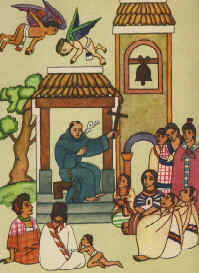
In 1531, ten years after the capture of Mexico City, peace allowed the mission fathers to teach the Catholic faith among the Indians and to baptize their children. At the beginning of December, a poor Indian named Juan Diego left his house one Saturday morning to attend divine service. On the way, as he passed the hill of Tepeyacac ("Hill of the Nose," in Nahuatl), he was startled by a song coming from the summit. The sweet, tender singing surpassed the trilling of the most exquisite birds. Juan Diego stopped, entranced, and mused, "Is it my luck to be worthy to hear such music? Is it a dream perhaps? Did I get up from my bed? Where am I? In Paradise, in heaven perhaps? I don't know."
The singing ceased and a heavenly sweet voice called him from the hill-top, "Juan, my little one, Juan Diego." Filled with joy, Juan Diego was not at all frightened, but climbed the hill in search of the mysterious voice.
When he reached the top, he saw a lady who bade him approach. It was a wonderful lady of superhuman beauty. Her raiment shone like the sun; the rock on which she set her foot seemed to be hewn from precious stones and the ground red like the rainbow. The grass, the trees and the bushes were like emeralds; the foliage, fine turquoise; and the branches flashed like gold.
Juan Diego bowed before her and the lady spoke: "Juan, my little one, the humblest of my children, where goest thou?"
"My lady, my child, I go to listen to such divine matters as our priests teach us," he replied.
"I am," said the wonderful Lady,"the Holy Mary, the eternal Virgin, Mother of the true God. I wish a shrine to be built here to show my love to you. I am your merciful mother, thine, and all the dwellers of this earth. To bring to pass what I bid thee, go thou and speak to the bishop of Mexico and say I sent thee to make manifest to him my will."
"My Lady," answered Juan Diego, "I go to fulfill thy command. I bid thee farewell, I thy humble servant."
The bishop received Juan, listened carefully to him, but did not believe the poor Indian's words. Juan Diego was very sad. That same day, he returned to the hill-top of Tepeyac.
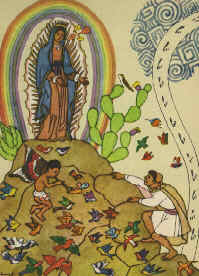
Lady and Mistress Mine
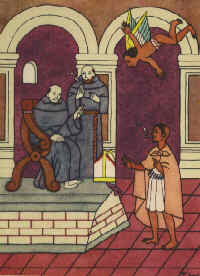
The Mother of Heaven was standing in the very same place where he had first seen her. He knelt before her and said:
"Lady, my Child, tiniest of my children, I went to fulfill thy command. I saw the prelate and related to him thy message. By his reply I realised he did not think it to be thy order. Send, Lady, a person of mark that he may believe it. My lady, I am a paltry fellow, a man of straw, a bumpkin, a commoner and Thou my child, my lady, didst send me to a place I go not, where I stay me not. Forgive me the great grief I cause thee, lady and mistress mine."
"Listen, my son, least of my sons," the Most Holy Virgin answered him, "Many are my servants whom I can charge with my message; yet I wish it to be thou to make my petition, to help by thy mediation my will to be accomplished. I charge thee, go again to the bishop, tell him again that the Holy Mary, Virgin Eternal, Mother of God, sends thee."
"My Lady," Juan Diego answered, "let me not bring thee vexation. With right goodwill shall I go to fulfill thy command and tomorrow evening at sunset I will come to give account of thy message. Now I take my leave of thee, my daughter, tiniest of my daughters, my daughter and lady."
Lady of Heaven
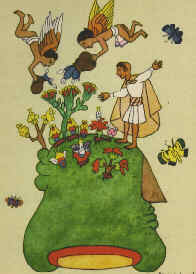
Next day, Sunday, Juan Diego left his house very early to take knowledge of divine matters. The mass over, he turned his steps at once to the Lord Bishop's palace and once again, with great difficulty, he was conveyed into his presence. He knelt at his feet and repeated the Virgin's message with sobs and entreaties. The Bishop put many questions to him about the apparition and he related everything with accuracy. The Bishop believed him not a whit more this time, thinking that the story was the product of the Indian's piety, and told him he must have some sign from the lady of heaven herself.
"Sir," said Juan Diego, "show me what sort of a sign thou dost want and I will go straight and ask for it of the lady of heaven who sent me."
The bishop sent some of his house-hold, whom he could trust, to follow him. Juan Diego went straight to the hill. When he had crossed the ravine near the Tepeyac bridge, the attendants lost sight of him and could not find him. So they returned to tell the Bishop he had mysteriously disappeared.
Meanwhile the good Juan was with the Lady of Heaven, giving her the Bishop's reply. The lady dismissed him saying,
"It is well, my son; thou shall return here tomorrow to take to the bishop the sign he has asked of thee. Then will he believe thee, and know, my son, that I shall reward thee for thy pains."
The next day Juan Diego did not return, for his uncle, Juan Bernardino, was gravely ill. He called a doctor in the morning and at night his uncle, feeling that his hour had come, asked him to go early to Tlaltelolco to find a priest. Juan did as he was bid, leaving at dawn, by his usual road; but drawing near to the hiil of Tepeyac, he stopped and thought. "If I go forward, I shall meet Our Lady, who will divert me to give the sign the prelate has asked for." So he turned to the west from the easterly road he was following, believing it paramount to fetch the priest to his dying uncle. As he circled the hill, he saw Our Lady treading majestically down the slope: she drew right near him and said, "What is happening, my son? Where goest thou?"
"My daughter," replied Juan Diego,--it will grieve thee to know that one of thy poor servants, my uncle, is very ill and dying of plague. I am going in a great hurry to call the priest to confess him and will come back here to take your message. Forgive me, lady and daughter mine, be patient with me, I am not deceiving thee, I will come tomorrow in aIl haste."
Am I Not Here, I Thy Mother?
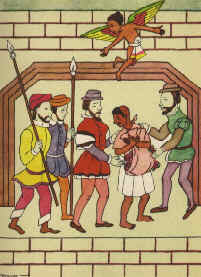
"Be not troubled nor afraid" replied the Virgin. "Am I not here, I thy mother? Art thou not beneath my protection? Am I not thy shield? Let not the sickness of thine uncle distress thee anymore, for he will not die yet. Thou canst rest assured that he is well even now."
When Juan heard these words, he felt comforted and happy.
"Go to the hill top, my son," the Virgin went on. "There shalt thou find flowers in plenty; pluck them, gather them into a bouquet, and come down at once to bring them here to me."
Juan Diego at once went off and, when he reached the top, he stood astonished before a choice variety of flowers blooming before their due season. They were fresh, covered with the night's dew, whose drops shone like precious pearls. Juan plucked the flowers and, descending at once, he offered the Virgin the heavenly blooms.
"My son," Our Lady said to him, "these flowers are the sign thou shalt take the bishop. Thou shalt tell him in my name to see my will in them. Thou shalt be my emissary, full worthy of my whole trust. I charge thee strictly to unfold thy cloak only before the bishop and show him the flowers. Thou shalt tell him all thou hast seen and wondered at."
In haste and with joy Juan Diego took the road to Mexico, with the wonderful flowers he was carrying in his arms.
Our Lady of Guadalupe
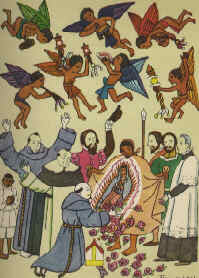
In the bishop's palace he had a long time to wait. The servants, suspecting from his attitude that he was hiding something in his arms, began to bait him. Seeing his refusal to show them what he was carrying, they began to tug at his cloak, in spite of the tearful petitions the poor Indian put up. Terrified the flowers would fall to the floor, he lifted a corner of his cloak to placate his tormentors. But a miracle! the blooms, fresh and fragrant before, to the gaze of the servants seemed as if stuck to Juan Diego's cloak. Then it was that the head steward and the servants rushed to announce that the Indian had come with the sign. The Lord Bishop commanded at once that he should be brought before him. Juan Diego prostrated himself before him and said:
"Sir, I have done thy command. I went and told the Lady of Heaven thou wast asking for a sign that thou mightest believe me."
The Indian related what the Holy Mother of God had told him and described the glory in which she had lately appeared to him. Then he unfolded his white cloak and, as the lovely blooms were strewn on the floor, the miraculous image of Our Lady of Guadalupe suddenly appeared on the cloth just as it is to be seen today, painted by a divine hand on the cape of Juan Diego.
The bishop and all the onlookers knelt down. Immediately thereafter the cape was hung in the chapel.
Mother of Life
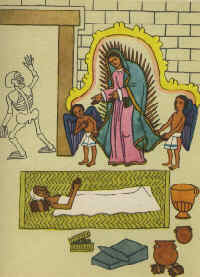
Juan Diego returned home and found his uncle happy and free of any pain. Juan Bernardino explained how the Lady of heaven had healed him and had asked that she should be called Holy Mary of Guadalupe.
Then there came, in pilgrimage, firstly Indians dancing followed by native warriors; Spaniards, and the civil authorities with the banner of Castile; some men carrying fans, as was the custom at that time, marched behind the Spanish ladies and the women of the country.
Then there followed the two religious orders of evangelistic friars: Dominicans and Franciscans. Preceding the sacred image carried by Bishop Zumirraga and Juan Diego, went Indians burning incense. After them an enormous multitude rendered an indescribable homage to the Virgin.
Thereafter the church was built in all its glory, and from alI parts come the pilgrims to perpetuate each day that procession; they comprise all races of mankind who kneel and pray beside the Indians, who link time past with the present in one faith and hope before the miraculous Image of Our Lady of Guadalupe.
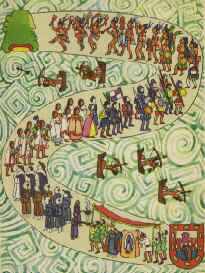
All About Mary includes a variety of content, much of which reflects the expertise, interpretations and opinions of the individual authors and not necessarily of the Marian Library or the University of Dayton. Please share feedback or suggestions with marianlibrary@udayton.edu.
